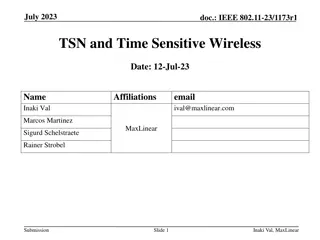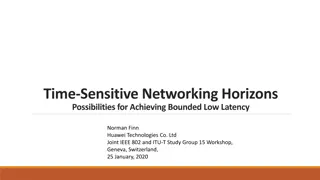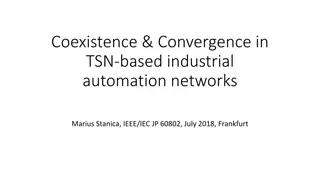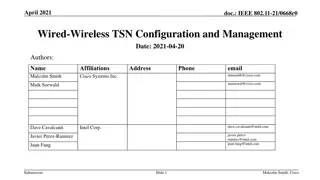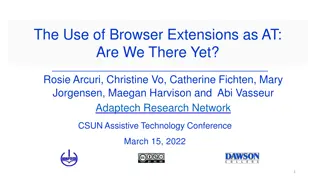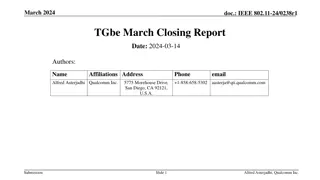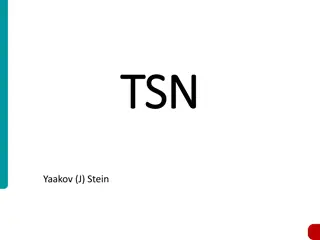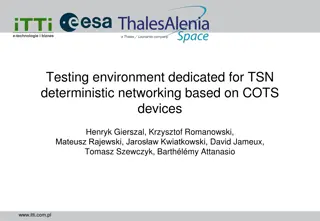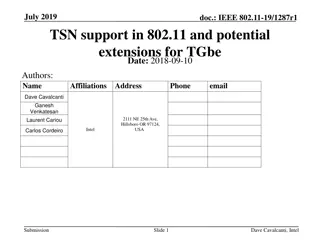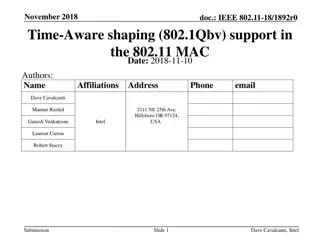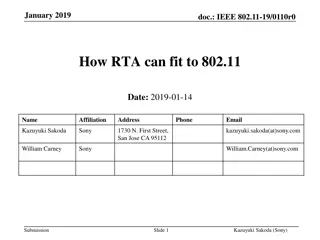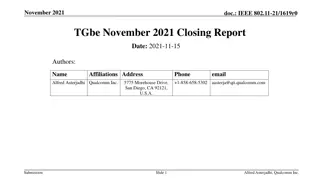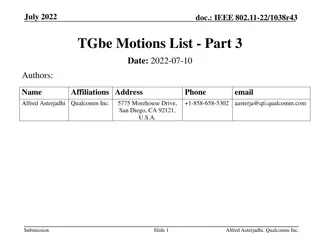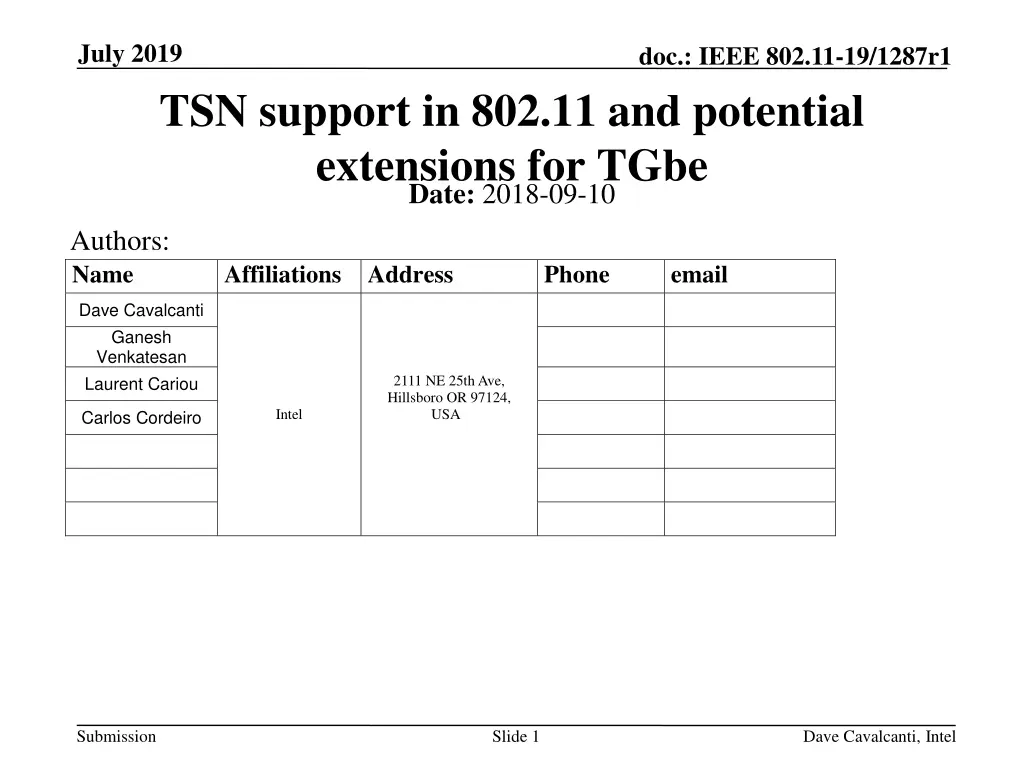
Wireless TSN Support and Applications
"Explore IEEE 802.11 standards and potential extensions for TSN support in wireless networks, covering time-sensitive networking background, use cases, requirements, and unique characteristics. Learn about applications in industrial automation, automotive, and more. Discover the shift from wired to wireless TSN, enabling high reliability, bounded latency, and coexistence of various traffic types."
Download Presentation

Please find below an Image/Link to download the presentation.
The content on the website is provided AS IS for your information and personal use only. It may not be sold, licensed, or shared on other websites without obtaining consent from the author. If you encounter any issues during the download, it is possible that the publisher has removed the file from their server.
You are allowed to download the files provided on this website for personal or commercial use, subject to the condition that they are used lawfully. All files are the property of their respective owners.
The content on the website is provided AS IS for your information and personal use only. It may not be sold, licensed, or shared on other websites without obtaining consent from the author.
E N D
Presentation Transcript
July 2019 doc.: IEEE 802.11-19/1287r1 TSN support in 802.11 and potential extensions for TGbe Date: 2018-09-10 Authors: Name Affiliations Address Phone email Dave Cavalcanti Ganesh Venkatesan Laurent Cariou 2111 NE 25th Ave, Hillsboro OR 97124, USA Intel Carlos Cordeiro Submission Slide 1 Dave Cavalcanti, Intel
July 2019 doc.: IEEE 802.11-19/1287r1 Abstract TGbe/EHT has defined worst-case latency and jitter improvements are part of its scope to address TSN applications as well as integration with Ethernet TSN This presentation provides an overview of the use cases/requirements, existing 802.11 capabilities defined to support 802.1 TSN standards and future extensions to be considered in TGbe/EHT. Submission Slide 2 Dave Cavalcanti, Intel
July 2019 doc.: IEEE 802.11-19/1287r1 Outline TSN background Wireless TSN use cases and requirements 802.11 support for 802.1 TSN Extensions for wireless TSN support in 802.11be Submission Slide 3 Dave Cavalcanti, Intel
July 2019 doc.: IEEE 802.11-19/1287r1 TSN (Time Sensitive Networking) Background TSN capabilities enable managed networks that provide the following features for time-critical data streams: Time synchronization between network nodes and hosts Timeliness (bounded latency) High reliability (very low packet loss) Coexistence of time-critical and other traffic types (e.g. best- effort) on the same network Submission Slide 4 Dave Cavalcanti, Intel
July 2019 doc.: IEEE 802.11-19/1287r1 From Wired (Ethernet) to Wireless TSN The IEEE 802.1 TSN Task Group develops standards to enable TSN features over IEEE 802 networks (e.g. Ethernet/802.3, Wi-Fi/802.11) CUC A TSN Domain (wired and wireless) is a managed (protected) domain CNC Admission control is required The network is provisioned to serve end-to-end TSN streams The CUC/CNC are responsible for user and network configuration (e.g. as defined in 802.1Qcc) End Device TSN Talker End Device TSN Listener TSN Switch Wired TSN Domain End Device End Device Wireless TSN Access Point Wireless TSN Domain CUC: Central User Configuration CNC: Central Network Configuration Unique characteristics of wireless media: links have variable capacity and are subject to noise and interference (especially in unlicensed bands) Submission Slide 5 Dave Cavalcanti, Intel
July 2019 doc.: IEEE 802.11-19/1287r1 Wireless TSN Applications AV Industrial Flexible factories (Industry 4.0), automation, mobile robots, AGVs, etc. Automotive In-vehicle HMI, multimedia, telematics Conference rooms, production rooms, concerts, etc. Wireless enables flexibility, lower maintenance costs (wire replacement) and mobility Main networking/connectivity requirements: Time synchronization (~1 sec or better ) Bounded (low) latency (average is NOT the issue, need worst-case bounds) High reliability (low packet loss) Submission Slide 6 Dave Cavalcanti, Intel
July 2019 doc.: IEEE 802.11-19/1287r1 Example Use Case: Industrial Control System Packets delivered after the deadline are considered lost Source: National Instrument/TTTech presentation, TSNA 2016 Latency, jitter and packet loss can cause instability of the system Low latency and high reliability enable the system to operate faster and without interruptions direct business value Submission 7 Dave Cavalcanti, Intel
July 2019 doc.: IEEE 802.11-19/1287r1 Low (worst-case) latency is also a requirement for other emerging applications Real-time mobile, console and cloud gaming Gaming Server Internet Access Point (AP) Gaming STA Access Point (AP) Gaming STA Latency/jitter cause lagging/bad user experience Submission Slide 8 Dave Cavalcanti, Intel
July 2019 doc.: IEEE 802.11-19/1287r1 RTA TIG use cases and requirements RTA TIG report doc.#: 11-18-2009 Use cases Intra latency/ms BSS Jitter variance/ms [4] < 2 < 2 Packet loss Data rate/ Mbps [1] Real-time gaming [2] Cloud gaming [15] < 5 < 10 < 0.1 % Near-lossless < 1 <0.1 (Reverse link) >5Mbps (Forward link) Real-time video [3] < 3 ~ 10 < 1~ 2.5 Near-lossless 100 ~ 28,000 Robotics and industrial automation [1] Equipment control < 1 ~ 10 < 0.2~2 Near-lossless < 1 Human safety < 1~ 10 < 0.2 ~ 2 Near-lossless < 1 Haptic technology <1~5 <0.2~2 Lossless <1 Drone control <100 <10 Lossless <1 >100 video with The main issue is worst-case latency Real-time applications need both low latency and low jitter Higher reliability is also an important new requirement Submission Slide 9 Dave Cavalcanti, Intel
July 2019 doc.: IEEE 802.11-19/1287r1 IEEE 802.1 Time Sensitive Networking (TSN) Standard Ethernet with synchronization, small and/or fixed latency, and extremely low packet loss TSN Std Components Time synchronization: Time Synchronization (802.1AS) Ultra reliability: Frame Replication and Elimination (P802.1CB) Path Control and Reservation (802.1Qca) Per-Stream Filtering and Policing (802.1Qci) Reliability for time sync (P802.1AS-Rev) Synchronization 802.1AS over 802.11 Timing Measurement (TM) Fine Timing Measurements (FTM) Reliability Reliability Latency Bounded low latency: Time-Aware traffic shaping (802.1Qbv) Preemption (802.1Qbu/802.3br) Cyclic Scheduling (802.1Qch) Asynchronous Scheduling (802.1Qcr) Resource Mgmt Dedicated resources Stream Reservation Protocol (802.1Qat) TSN configuration (P802.1Qcc) YANG (P802.1Qcp) Link-local Registration Protocol (P802.1CS) 802.11aa (SRP over 802.11 for AV) 802.11ak (802.11 links in an 802.1Q LAN) Zero congestion loss Credit: J nos Farkas, Ericsson TSNA Conference 2017 These TSN Capabilities are the main gaps that need further support from Wireless Media: - Ongoing work in 5G NR URLLC (Rel. 16) - Opportunity to leverage 802.11ax and include further support in 802.11be New capabilities to manage bounded latency/reliability over wireless may also be needed Submission Slide Dave Cavalcanti, Intel 10
July 2019 doc.: IEEE 802.11-19/1287r1 TSN Time Synchronization over 802.11 TSN applications and protocols to operate on single reference clock across multiple nodes/hosts in the network TSN Switch 802.11 Wireless TSN Link TSN Listener (Wi-Fi Client) TSN Talker TSN-enabled Access Point A PLC s control cycle needs to be synchronized with other PLCs/Sensors/Actuators TSN Time-Aware protocols (e.g. Qbv) operate based on the same reference clock to ensure data delivery aligned with the timing requirements of the applications Submission 11 Dave Cavalcanti, Intel
July 2019 doc.: IEEE 802.11-19/1287r1 802.1AS-based Time Synchronization over 802.11 802.1AS enables the distribution of a single, accurate, time reference across the network (one time reference for the entire TSN domain) 802.11 defined MAC specific support for 802.1AS (e.g. Timing Measurement and Fine Timing Measurement) 802.1AS time synch over 802.11 ( defined in the IEEE 802.11-2012 spec) 802.11 Timing Measurement frames are used to compute: LinkDelay = [(t4-t1)-(t3-t2)]/2 NeighborRateRatio (PPM offset to neighbor) = (t1 -t1)/(t2 -t2) TimeOffset = [(t2-t1)-(t4-t3)]/2 Ref: K. Stanton, Tutorial: The Time-Synchronization Standard from the AVB/TSN suite IEEE Std 802.1AS - 2011, IEEE 802 Plenary, July 2014 Submission Slide 12 Dave Cavalcanti, Intel
July 2019 doc.: IEEE 802.11-19/1287r1 Time-Aware Shaping (802.1Qbv) over Wireless A Time-aware (Qbv) scheduler defines when gates open/close to ensure time-sensitive frames are not interfered by other traffic AP A Qbv schedule can operate on top of one of the 802.11 MAC modes (e.g. EDCA, 802.11ax Trigger based access) The 802.11 network must execute the schedule and deliver frames with bounded latency. Support for exchanging Qbv schedules over the air is also needed. Randomness in the 802.11 MAC (e.g. due to contention) will impact achievable latency bounds and capacity/efficiency A scheduled operation (e.g. based on 802.11ax triggered access) can provide more predictable latencies/higher efficiency Queues/Traffic Classes T T T T Shared medium T T T T T T T T STA 2 STA 1 Submission Slide 13 Dave Cavalcanti, Intel
July 2019 doc.: IEEE 802.11-19/1287r1 Bounded latency performance can be enhanced in 802.11 Congestion due to contention within a BSS and across OBSSs causes variations in channel access latency EDCA has been successful in resolving contention, but it cannot provide hard bounds on latency/jitter, especially under congestion TSN requires a managed network approach: 802.11be can provide the tools to manage the network to address the bounded latency/jitter performance under managed OBSS operation This will enable 802.11 to support wireless TSN use cases in private network environments (e.g. enterprise, factories, etc.) Submission Slide 14 Dave Cavalcanti, Intel
July 2019 doc.: IEEE 802.11-19/1287r1 Managed OBSS Scenario in 802.11be Assumptions: APs are under the control of a single entity and coordination is feasible Interference from unmanaged STAs/OBSSs can be minimized (network wide admission control and other management tools can be applied) Traffic patterns: Predictable time-sensitive flows (require bounded latency/jitter with high reliability) Unpredictable/bursty traffic (non-time-sensitive, but low latency is desirable) 802.11be Multi-AP and multi-band enhancements can include the coordination protocol and security procedures to enable a Managed OBSS scenario, e.g. Enable managed APs form a coordination group with a Coordinator AP, and establish a security relationship between Coordinator AP and Coordinated APs AP Coordinator AP Coordinated AP Potential managed OBSS scenarios: enterprise, factory, some home deployments STA STA Coordinated AP STA STA STA STA Submission Slide 15 Dave Cavalcanti, Intel
July 2019 doc.: IEEE 802.11-19/1287r1 Enhancements to support TSN-grade bounded latency in 802.11be Time-sensitive traffic identification and requirements (within and across BSSs) Protocol enhancements to announce time-sensitive requirements and get confirmation of service Efficient scheduled operation for predictable time-sensitive traffic Enable AP to control contention within the BSS with Trigger-only access and extend capability to multiple managed OBSSs Mechanisms to control contention when EDCA is used (e.g. limit TXOP duration/contending STAs) Traffic isolation mechanisms (time-sensitive network slicing) It is relatively easy to schedule resources to serve predictable time-sensitive traffic But the network must also support a mix of predictable (time-sensitive) and unpredictable traffic (best- effort, other non-time-sensitive) efficiently Need mechanisms to protect time-sensitive traffic from other traffic/STAs Need to allow STAs (with unpredictable traffic) to indicate resource requests, traffic description updates, power save state changes, buffers reports Need efficient recovery mechanisms (transmission errors, busy NAV during allocation, ) Multi-AP resource coordination across managed OBSSs Submission Slide 16 Dave Cavalcanti, Intel
July 2019 doc.: IEEE 802.11-19/1287r1 Simulation results: Example TSN performance in a managed BSS Scenario Latency bounds can be provided with high reliability with (1) Traffic identification and (2) Trigger-based access in a managed BSS scenario Capacity vs. Latency bound (msec) for Target PDR = 99.999% Example traffic model 50 45 Capacity for a PDR=99.999% 40 35 28 30 18 20 9 10 0 Channel access modes: 802.11ax Multi-user Trigger-based only with time-sensitive scheduling optimizations Capacity = number of STAs that can be supported with a given latency bound (1 3 msec) and 99.999% reliability 1 1.5 UL Latency Bound (msec) 2 2.5 3 PDR: Packet Delivery Ratio (fraction of packets successfully delivered within the latency bound) Assumptions: 20 MHz channel, SISO, 100 Bytes packets, Channel model E, STAs randomly distributed in a 50 m radio, latency-optimized scheduling strategy. Submission Slide 17 Dave Cavalcanti, Intel
July 2019 doc.: IEEE 802.11-19/1287r1 Additional TSN capabilities Although low latency is a primary target, reliability is equally important for TSN applications Data must be delivered within the deadline with high reliability Redundancy through multiple links is used to increase reliability in wired (Ethernet) TSN (e.g. defined in 802.1CB) Once latency bounds and reliability targets are met It is important to maximize the capacity of the network (for both time-critical and other traffic) business viability Frame preemption enables lower worst-case latency and higher efficiency (802.1Qbu/802.3br) Submission Slide 18 Dave Cavalcanti, Intel
July 2019 doc.: IEEE 802.11-19/1287r1 Redundancy and Interference Management Some applications require extremely high reliability (many 9 s) Redundant links (as defined in 802.1CB) are used in Ethernet to recover from device and medium errors Significant reliability gap to overcome in 802.11, especially given the potential for interference in unlicensed bands Multiple links/APs/channels can be leveraged for redundancy Mechanisms to isolate ( protect ) time-sensitive devices/traffic from other traffic can reduce managed interference (i.e. from managed devices) Redundancy is needed to recover from unmanaged interference Redundant transmissions can ensure data is delivered if link performance is degraded due to interference (e.g. from rough devices) Detecting and managing interference will also be important Submission Slide 19 Dave Cavalcanti, Intel
July 2019 doc.: IEEE 802.11-19/1287r1 Preemption (802.1Qbu/802.3br) Large frame transmissions increase worst-case latency for time-sensitive frames A guard band (GB) of the size of the largest (BE) fame is needed before the scheduled period starts less efficient/reduced capacity Guard band Time-sensitive frame arrival Increased worst-case latency Best-Effort frame BE transmission Preemption reduces worst-case latency for time-sensitive frames and increases efficiency (smaller guard band for scheduled traffic) Time-sensitive frame arrival Low latency (cut-through) performance for time-sensitive traffic Frag2 Frag1 802.3br defines MAC enhancements to support preemption in Ethernet Define and handle express and preemptable frames Arbitrate between express (time-sensitive) and preemptable frames Preserve frame integrity (fragmentation/reassembly) 802.11 support for preemption could be considered Submission Slide 20 Dave Cavalcanti, Intel
July 2019 doc.: IEEE 802.11-19/1287r1 Conclusions TSN support in 802.11 should continue to be aligned/integrated with 802.1 TSN standards 802.11be provides the opportunity to enable the next set of TSN capabilities that address latency and reliability performance vectors 802.11be can enable the tools to achieve bounded latency in managed scenarios Enable the possibility to control the behavior of contending devices Multi-link/AP capabilities and support for time-aware (Qbv) scheduling Reliability enhancements are needed to ensure the latency performance can be maintained in the presence of interference Multi-AP and multi-channel/bands can be leveraged for redundancy Efficiency will be important to enable practical/viable deployments Preemption and other efficiency enhancements (e.g. reduced overhead, especially, for small packets) may also be considered Submission Slide 21 Dave Cavalcanti, Intel
July 2019 doc.: IEEE 802.11-19/1287r1 References Doc#: 802.11-18-2009r6 Doc#: 802.11-18/1892r0 Doc#: 802.11-19/0373r0 Submission Slide 22 Dave Cavalcanti, Intel

